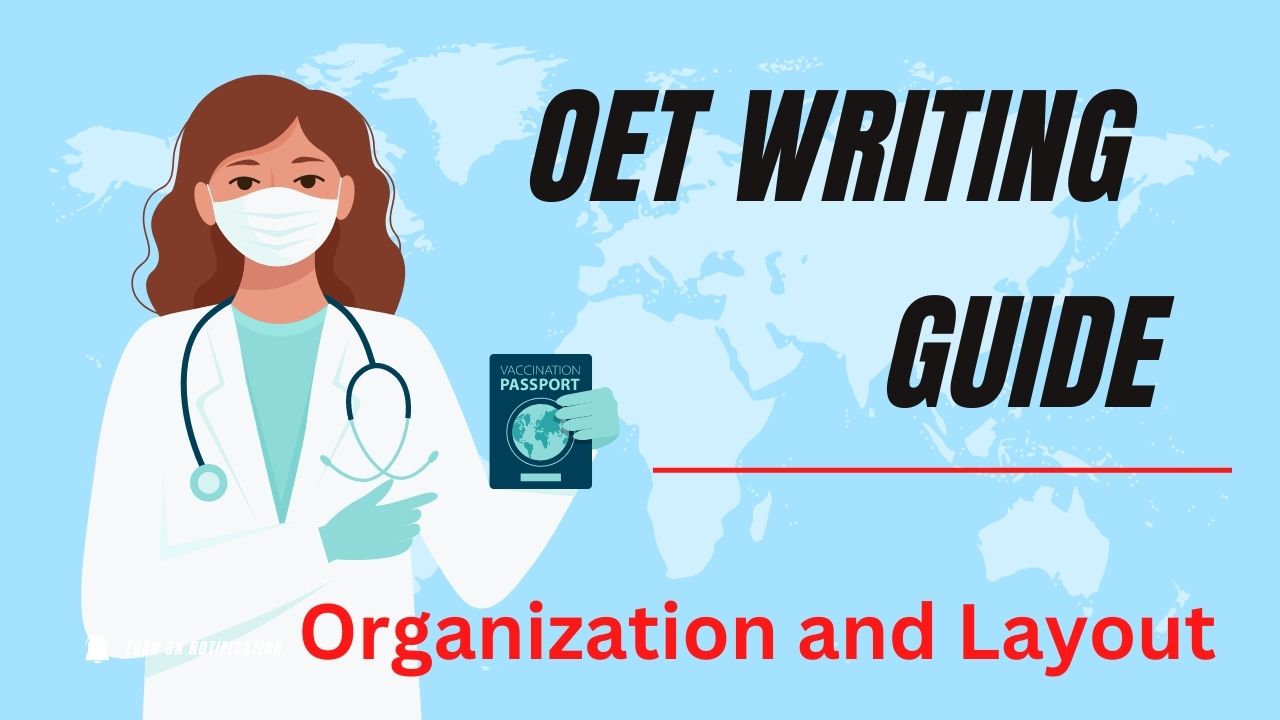OET Writing Guide: Organization and Layout
OET Writing Guide: Organization and Layout: Assessors use the fifth criterion to score your Writing performance, which is Organisation and Layout. It assesses how you order your letter and helps assessors determine whether your structure facilitates or hinders reader comprehension.
In this guide, you will:
- Discover the importance of organisation and layout
- Learn the techniques for ordering information in your letter
- Learn how to group information into paragraphs effectively.
Putting your information in place
Once you have decided on the information to include and not include from the case notes, you now need to decide the order in which you will present the information.
The situation you are describing and your requests are not the same for each writing task and its case notes. As a result, each letter will have a slightly different structure.
Think of your letter as the patient’s story. When handing over a patient to colleagues at a shift change or referring the patient to a specialist over the phone, we often narrate the patient’s story.
The order of information in the story is adjusted depending on the audience. This is done to capture their attention and maintain their engagement while presenting the remaining data. This is what you need to do with your letter.
Put yourself in the reader’s shoes. If you received this letter, which information would you want first, second, and so on?
Let’s explore different ways to structure the letter based on the patient’s situation.
Put yourself in the reader’s shoes. If you received this letter, which information would you want first, second, and so on?
Let’s explore different ways to structure the letter based on the patient’s situation.
Chronologically
In some situations, the clearest way to organise the letter is around time. You start at the beginning and continue up to the present day, for example:
Reader: Endocrinologist
Paragraph one: Mrs Shah initially presented on 29/12/18…
Paragraph two: A pathology report received on 05/01/2019…
Paragraph three: On 12/01/19…
The reader finds Mrs Shah’s situation quite routine. The writer employs dates at the beginning of each paragraph to separate the details of her visits, forming a clear and easy-to-follow timeline for the reader.
When describing an emergency in the case notes, the importance of what happened six months ago during the initial visit becomes less important to the reader. Instead, their focus lies on recent events, provided treatment, and the current situation of the patient. With this in mind, they can scan the remainder of the letter to identify any additional insights presented by the patient’s medical history.
Thematically
To organise a letter, one can put the most important information first. This approach is suitable when there are various aspects to the patient’s current situation, such as their living and family situation, co-morbidities, and so on. In such cases, presenting the information thematically is the most appropriate way to communicate with the reader.
Let’s take a look at an example.
Reader: Doctor
Paragraph One: Since October 2018, Mr Dun has shown signs of diabetic neuropathy… and has not been compliant with his medication regimen…
Paragraph Two: In June 2018, he had a myocardial infarction…His hypertension is controlled by Ramipril.
The letter presents the patient’s history timeline, similar to the last example because the reader needs to understand what happened and when. However, it organizes the information thematically rather than chronologically.
The first paragraph addresses the patient’s diabetes and his non-compliance with medication, as per the purpose of this letter (write a letter outlining the patient’s history and request ongoing monitoring). The second paragraph provides relevant background detail about related medical events and co-morbidities, which are of less importance but still relevant for the reader.
In other letters, thematic paragraphs can focus on different aspects such as the patient’s social history, previous advice and education they have received, relevant family history, and the impact these factors have on the patient’s perception of the
Review your paragraphs…
There is no limit to the paragraphs you include. You can include as many paragraphs as necessary to communicate the information to the reader. Some situations may require fewer paragraphs, while others may require more.
If you discover that your letter contains a very long paragraph, take a few minutes at the end to:
- Ensure that the section covers only one time period or theme.
- Determine whether you should split the paragraph into two.
…and the order of your sentences
This criterion assesses your ability to make the right choice about the order in which you include information. It’s not just about structuring the paragraphs in the clearest order for the reader. You should also ensure the important details are not hidden within the paragraph. Apply the same approach to the order of your sentences. Place the sentence containing the most important information for that paragraph first, the next most important sentence second, and so on. Failing to demonstrate this criterion correctly means that even if you have included all the information the reader needs, but not in the order they would prefer, you will not have demonstrated it correctly.
Conclusion:
Effective organization and layout play a crucial role in achieving success in the OET writing sub-test. By understanding the task, creating a clear outline, and organizing your ideas coherently, you can enhance the readability and impact of your response. Pay attention to formatting and presentation to create a professional and visually appealing piece of writing. With these tips in mind, you can confidently approach the OET writing tasks and showcase your language skills in a healthcare context.
For more resources check out our Youtube Channel
15-hour All-Inclusive OET Course!

